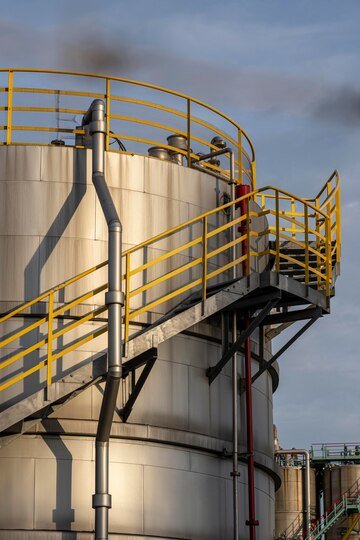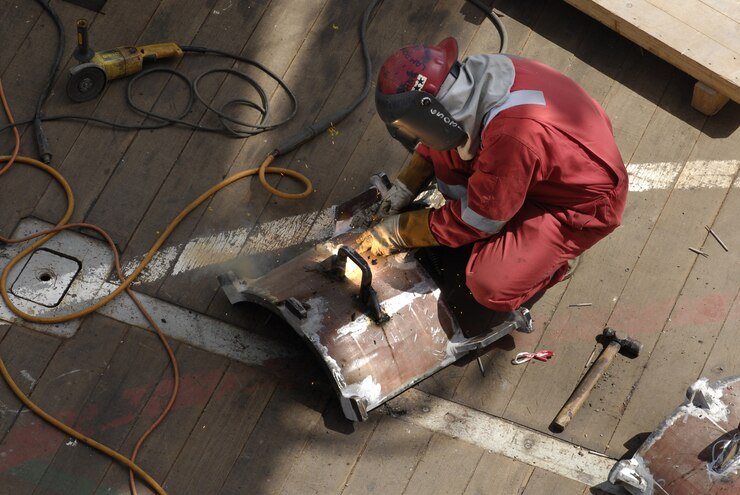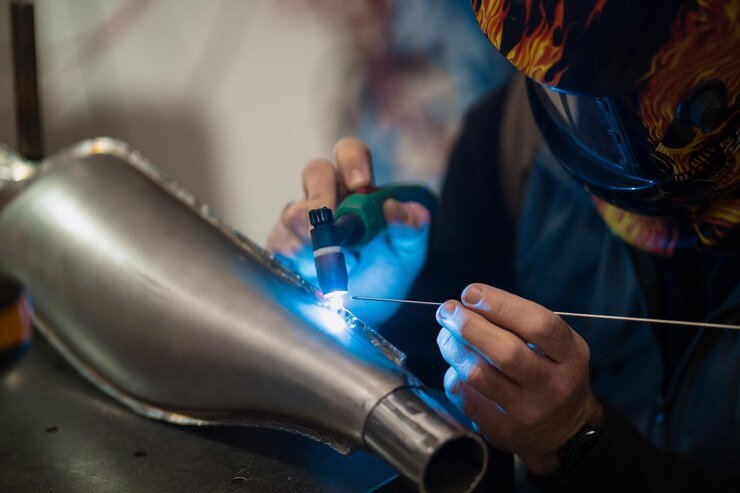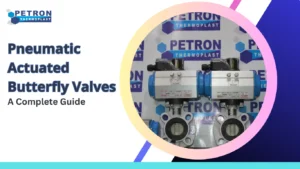In the realm of industrial applications, the significance of welding materials cannot be overstated. As various welding techniques continue to evolve, one method that has gained considerable attention is plastic welding, and within this domain, PVDF plastic welding rods have emerged as a game-changer. In this comprehensive exploration, we will delve into the myriad benefits of employing these specialized welding rods, shedding light on why they have become a preferred choice in diverse sectors.
Understanding the Essence of PVDF Plastic
Before unraveling the advantages of using PVDF plastic welding rods, it’s imperative to grasp the essence of PVDF itself. Polyvinylidene fluoride (PVDF) is a high-performance thermoplastic polymer with remarkable chemical resistance and mechanical strength. Its unique properties make it an ideal candidate for various industrial applications, including the fabrication of pipes, tanks, and Polycarbonate sheets.
Unparalleled Chemical Resistance
One of the standout benefits of utilizing PVDF plastic welding rods lies in their unparalleled chemical resistance. In industrial settings where exposure to corrosive substances is commonplace, the ability of PVDF to withstand a diverse range of chemicals becomes a crucial factor. From acids to solvents, PVDF remains resilient, ensuring the longevity and reliability of welded structures.
Exceptional Thermal Stability
PVDF plastic boasts exceptional thermal stability, making it an excellent choice for applications requiring exposure to high temperatures. Whether it’s in the manufacturing of chemical processing equipment or the creation of intricate components for the aerospace industry, the ability of PVDF to maintain its structural integrity under elevated temperatures is a key advantage that enhances the overall performance and safety of the final product.
Mechanical Strength and Durability
In the realm of structural integrity, the mechanical strength of materials used in welding is paramount. PVDF plastic welding rods excel in this regard, offering a robust and durable solution for joining plastic machined components. The resulting welds exhibit high tensile strength and toughness, ensuring that the bonded structures can withstand the rigors of diverse environments.
The Benefits of Employing PVDF Plastic Welding Rods
Now that we’ve established the foundational characteristics of PVDF plastic, let’s delve into the specific advantages of using welding rods crafted from this exceptional material.
1. Chemical Compatibility
The chemical compatibility of PVDF plastic welding rods is a standout feature that sets them apart in the world of plastic welding. The rods seamlessly integrate with PVDF base materials, creating welds that are not only structurally sound but also maintain the chemical resistance inherent to PVDF. This compatibility extends the lifespan of welded structures and ensures their effectiveness in environments where exposure to harsh chemicals is a constant factor.
2. Precision Welding
Precision is a paramount consideration in many industries, and PVDF plastic welding rods shine in this aspect. The ability to achieve precise and intricate welds is a testament to the inherent qualities of PVDF, coupled with the skillful utilization of specialized welding techniques. Whether it’s in the fabrication of intricate components for medical devices or the assembly of electronic modules, the precision offered by PVDF plastic welding rods contributes to the overall quality and functionality of the end product.
3. Versatility in Applications
The versatility of PVDF plastic welding rods is a key factor that enhances their appeal across diverse applications. From the automotive industry to chemical processing plants, these welding rods find utility in an array of sectors. The adaptability of PVDF plastic to various manufacturing processes, coupled with the compatibility of the welding rods, makes them a go-to choice for professionals seeking a versatile and reliable welding solution.
4. UV Resistance
Exposure to ultraviolet (UV) radiation can have detrimental effects on many materials, leading to degradation and loss of structural integrity. PVDF plastic and its welding rods, however, exhibit exceptional UV resistance. This feature makes them well-suited for outdoor applications, where prolonged exposure to sunlight is inevitable. From constructing outdoor signage to fabricating components for solar panels, the UV resistance of PVDF plastic welding rods ensures the longevity and performance of the welded structures.
5. Ease of Processing
In the realm of manufacturing, efficiency is often a driving force. PVDF plastic welding rods contribute to this efficiency by offering ease of processing. The material’s inherent properties, such as its low melting point and flow characteristics, make it conducive to efficient welding processes. This, in turn, translates to time and cost savings for manufacturers, making PVDF plastic welding rods a practical choice for those seeking both quality and efficiency in their welding operations.
6. Environmental Sustainability
Sustainability is a growing concern in today’s industrial landscape, and materials that align with eco-friendly practices are gaining traction. PVDF plastic is known for its recyclability, and when used in welding, it contributes to environmentally sustainable practices. The ability to recycle PVDF plastic welding rods not only reduces the environmental footprint but also aligns with the broader goals of promoting a circular economy in the manufacturing sector.
7. Resistance to Weathering
Outdoor applications often subject materials to the whims of weathering, including exposure to rain, wind, and temperature fluctuations. PVDF plastic welding rods exhibit exceptional resistance to weathering, ensuring that the welded structures maintain their integrity and aesthetics over extended periods. This resistance to environmental factors adds a layer of reliability, making PVDF plastic welding rods a preferred choice for projects that demand long-term durability.
8. Low Thermal Conductivity
In applications where thermal conductivity is a consideration, the low thermal conductivity of PVDF plastic welding rods becomes a valuable attribute. This property is particularly beneficial in scenarios where minimizing heat transfer is crucial, such as in the fabrication of electronic components or the assembly of sensitive instruments. The low thermal conductivity of PVDF plastic contributes to the preservation of temperature-sensitive materials during the welding process.
9. Medical Device Manufacturing
In the intricate world of medical device manufacturing, precision and biocompatibility are paramount. PVDF plastic welding rods, with their ability to deliver precise and intricate welds, find applications in assembling components for medical devices. The chemical resistance of PVDF ensures that the welded structures maintain their integrity even when exposed to sterilization processes, making them a preferred choice in this highly regulated industry.
10. Semiconductor Fabrication
The semiconductor industry demands materials that can withstand stringent manufacturing processes and provide the necessary thermal and chemical stability. PVDF plastic welding rods, with their low thermal conductivity and exceptional chemical resistance, play a crucial role in the assembly of components for semiconductor devices. Their ability to contribute to the creation of reliable and durable connections in electronic circuits is invaluable in this technologically advanced field.
11. Aerospace Engineering
In the aerospace sector, where components are subjected to extreme conditions, the mechanical strength and thermal stability of materials are of utmost importance. PVDF plastic welding rods, known for their exceptional mechanical strength and resistance to high temperatures, become integral in the fabrication of aerospace components. From fuel systems to structural elements, the use of PVDF plastic welding rods ensures the production of components that can withstand the rigors of space exploration and aviation.

12. Chemical Processing Plants
Chemical processing plants often handle corrosive substances that pose a challenge to the longevity of materials. PVDF plastic welding rods, with their unrivaled chemical resistance, find extensive applications in the assembly and repair of pipelines, tanks, and equipment within these plants. The ability of PVDF plastic to resist degradation in the face of harsh chemicals ensures the structural integrity of welded components, contributing to the safety and efficiency of chemical processes.
13. Renewable Energy Infrastructure
As the world shifts towards renewable energy sources, materials that can endure outdoor conditions become crucial in the fabrication of solar panels and other renewable energy infrastructure. The UV resistance and weathering capabilities of PVDF plastic welding rods make them an ideal choice for such applications. Their use contributes to the longevity and reliability of solar panels and other renewable energy components, furthering the sustainability goals of the energy industry.
14. Automotive Manufacturing
In the automotive manufacturing sector, where a balance between weight, strength, and durability is paramount, PVDF plastic welding rods find a niche. The versatility of these welding rods allows for the fabrication of lightweight yet sturdy components. From fuel tanks to interior components, the use of PVDF plastic welding rods contributes to the overall efficiency and performance of vehicles while meeting stringent safety standards.
15. Water Treatment Facilities
Water treatment facilities rely on materials that can withstand exposure to various chemicals and environmental conditions. PVDF plastic welding rods, with their chemical resistance and environmental sustainability, play a vital role in the assembly and maintenance of pipes, valves, and other components within water treatment facilities. Their ability to resist corrosion ensures the longevity of the infrastructure, contributing to the efficient treatment of water for communities.

The Future of PVDF Plastic Welding
As technology and industries continue to advance, the applications of PVDF plastic welding rods are poised to expand even further. The continuous quest for materials that offer a combination of strength, durability, and environmental compatibility positions PVDF plastic as a key player in the future of welding technology. The adaptability of PVDF plastic to diverse industries underscores its significance in shaping the landscape of material science and engineering.
In conclusion, the benefits of using PVDF plastic welding rods extend far beyond the realm of conventional plastic welding. Their unique properties make them indispensable in sectors that demand precision, durability, and resistance to harsh conditions. As we look to the future, the role of PVDF plastic welding rods is likely to evolve, contributing to advancements in various industries and exemplifying the power of innovation in welding technology.
FAQs) About PVDF Plastic Welding Rods
1. What is PVDF plastic?
PVDF stands for Polyvinylidene fluoride, which is a high-performance thermoplastic polymer known for its exceptional chemical resistance, mechanical strength, and thermal stability. It is commonly used in various industrial applications, including the fabrication of pipes, tanks, and sheets.
2. What are PVDF plastic welding rods?
PVDF plastic welding rods are specialized rods made from Polyvinylidene fluoride. These rods are used in plastic welding processes to join PVDF plastic components. The welding ensures strong and durable bonds, maintaining the chemical and mechanical properties of the base PVDF material.
3. What are the benefits of using PVDF plastic welding rods?
The benefits of using PVDF plastic welding rods are extensive:
- Chemical Compatibility: Welds maintain chemical resistance inherent to PVDF.
- Precision Welding: Allows for intricate and precise welds in various applications.
- Versatility: Suitable for a wide range of industries and applications.
- UV Resistance: Withstands exposure to ultraviolet (UV) radiation for outdoor applications.
- Ease of Processing: Exhibits low melting point and flow characteristics for efficient welding.
- Environmental Sustainability: PVDF plastic is recyclable, contributing to eco-friendly practices.
- Resistance to Weathering: Maintains structural integrity in outdoor environments.
- Low Thermal Conductivity: Useful in applications requiring minimized heat transfer.
4. In which industries are PVDF plastic welding rods commonly used?
PVDF plastic welding rods find applications in diverse industries, including:
- Medical Device Manufacturing: Precision welding for biocompatible components.
- Semiconductor Fabrication: Contributing to reliable electronic circuit connections.
- Aerospace Engineering: Ensuring mechanical strength and thermal stability in aerospace components.
- Chemical Processing Plants: Welding pipes, tanks, and equipment with high chemical resistance.
- Renewable Energy Infrastructure: Used in solar panels and other renewable energy components.
- Automotive Manufacturing: Fabrication of lightweight and sturdy automotive components.
- Water Treatment Facilities: Assembly and maintenance of pipes and valves with chemical resistance.
5. Are PVDF plastic welding rods environmentally friendly?
Yes, PVDF plastic is known for its recyclability, contributing to environmental sustainability. The ability to recycle PVDF plastic welding rods aligns with the broader goals of promoting a circular economy in the manufacturing sector.
You May Also Like : PVC 3-Way Ball Valve Installation Guide From Petron Thermoplast
What Types Of Materials Are Used For Plastic Bearing?
Why Are Ball Valve Made Of Stainless Steel




